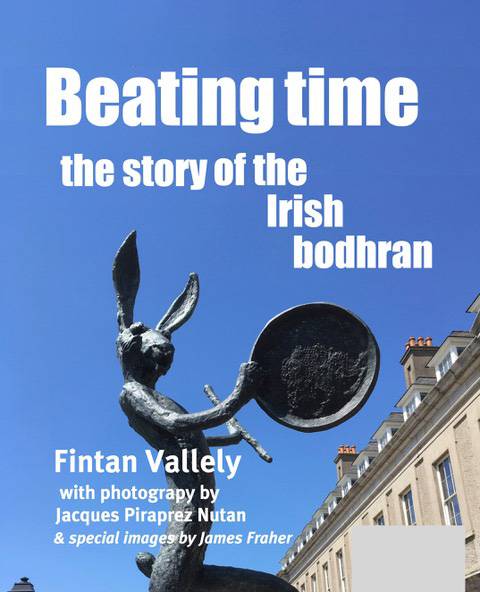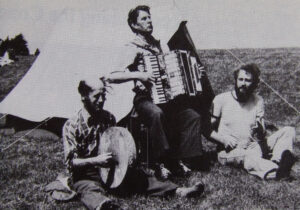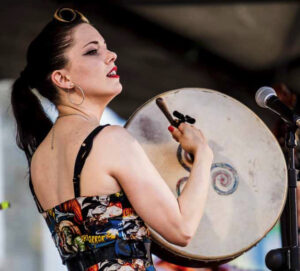Beating Time – The Story of the Irish Bodhrán: Winter, 2024

A unique, newly-researched, full history of the tambourine and bodhrán in Ireland
The bodhrán drum has become a symbol of Ireland, as well known by now as the classic harp. Remarkably, it became visible only in the mid-1900s, but rapidly achieved a tremendous popularity. It is typically assumed to be the ancient, Irish percussion, but investigation of museum objects, images, fiction and history, newspaper reports, advertising and folklore shows that there is no historic, percussion dimension to Irish music at all: it is demonstrably melodic. There was, however, since the ancient past, a well-documented (but now defunct) device called bodhrán that was a subsistence-era, household container and winnowing tool that came to be improvised as a drum on rituals like the Wren each winter. But in the mid-1700s the European tambourine was introduced to Ireland by the music trade and popular stage-shows, was copied by rural artisan sieve-makers, and took over as the Wren’s symbolic percussion. Development of the Wren as a cultural festival in the 1950s led not only to the tambourine being adopted into revived Traditional music, but to the old term ‘bodhrán’ being reclaimed to describe it, a re-branding that took hold after 1960. Today the bodhrán has been hugely developed through interaction between the expanding expertise of its most virtuosic players and the innovations of its makers in Ireland and abroad, and is played widely in not only traditional Irish music, but in other genres as well. All of this marks the bodhran as not the oldest Irish-music instrument, but the newest, in such recent time that, remarkably, most of those who created its styles and forms are still part of today’s Irish music scene.
 Summary
Summary
The bodhrán was made visible by Seán Ó Riada’s ensemble Ceoltóirí Chualann. Inside a couple of decades it was widely known, and assumed to have an ancient pedigree. By now the bodhrán’s remit is international, with a symbolism not only in Irish music, but also in tourism and sport. Though numerous articles and studies have explored it, to date there has been no coherent picture of how it seemed to appear so suddenly in the twentieth century. This book now adds to the work of such as Mícheál Ó Súilleabháin, and also clears the air of many myths and assumptions. It observes that the name bodhrán is ancient, a word once used for a millennia-old skin-covered tool, container and tray, but which came to be applied to locally-made copies of the Popular-music tambourine in the mid-1900s.
 Of great relevance to musicians and to Irish Studies readers alike, breezily-written and fully referenced, this diverse, fascinating history explores the rural and urban, national and international, academic and vernacular. It finds evidence in archaeology, museums, printed and painted images, fiction and history texts, dictionaries, newspaper reports, advertising and transcribed folklore. The conclusion arrived at is that Irish music historically has been melody based, with no percussive dimension, and, as a music instrument, the bodhran has in fact a relatively short history that begins in the 1800s, mostly happening after 1960. So, rather than being imagined as an archaic Irish music instrument, perhaps it deserves to be celebrated more for being a new one?
Of great relevance to musicians and to Irish Studies readers alike, breezily-written and fully referenced, this diverse, fascinating history explores the rural and urban, national and international, academic and vernacular. It finds evidence in archaeology, museums, printed and painted images, fiction and history texts, dictionaries, newspaper reports, advertising and transcribed folklore. The conclusion arrived at is that Irish music historically has been melody based, with no percussive dimension, and, as a music instrument, the bodhran has in fact a relatively short history that begins in the 1800s, mostly happening after 1960. So, rather than being imagined as an archaic Irish music instrument, perhaps it deserves to be celebrated more for being a new one?
To be published in winter, 2024. Advance interest welcome …
Book format: Large format, colour printed, c. 340 pages in 17 main chapters, with 300 images.
Fintan Vallely will be doing a talk on the project and on the tambourine/bodhran at Craiceann, Inis Oírr, on June 25th
